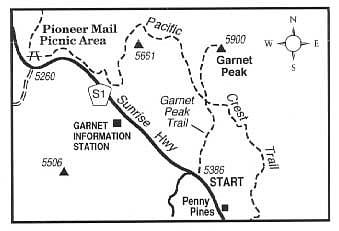 Facebook
Facebook
 X
X
 Instagram
Instagram
 TikTok
TikTok
 Youtube
Youtube
Although Garnet Peak isn't the highest peaklet along the steep eastern escarpment of the Laguna Mountains, its exposed position makes it a fine place to view both the pine-clad high country and the raw desert below. For the next few weeks -- or until the coming winter rains soak the ground -- that view of raw terrain will include the mountain itself. Summer's Pines fire burned the mountain and the desert-facing slope of the northern Laguna Mountains to a crisp.
In late fall and winter, whenever east or north winds chase away air pollution and haze, Garnet Peak is simply the best spot in the county to greet the morning sun, which pops up over the desert wastes of northwestern Sonora, Mexico, some 150 miles away. On the clearest mornings, you can witness the almost-mythical "green flash," an optical phenomenon commonly associated with the sun's disappearance over the Pacific Ocean in the west and less noticed when the sun reappears in the east.
The Garnet Peak Trail, 1.2 miles long, starts near mile 27.8 (as reckoned by the green milepost signs) on Sunrise Highway. This is about 5 miles north of the small resort community of Mount Laguna. Park your car nearby, off the pavement, and take the signed Garnet Peak Trail north. After several hundred yards in unburned Jeffrey pine forest, you enter the burn zone and cross the Pacific Crest Trail. Continue north on a rocky path slanting upward through what used to be (and will again be in a few years) low-growing chaparral vegetation. This uphill segment of the trail can be an ankle-twisting experience, especially at dawn when the seemingly substantial, angular stones caught in your flashlight beam still manage to roll unexpectedly underfoot.
From the rock outcrops at the summit, the mountain falls away abruptly, revealing a vertiginous panorama of ashen Storm Canyon. Far below and well beyond the burned area, Storm Canyon's alluvial fan spreads eastward across the desert floor. On clear fall or winter days you'll spot the Salton Sea in the east and Baja's Laguna Salada dry lakebed in the southeast. To the south and west, the Laguna Mountain crest, dusky with oak and pine forests, singed here and there by the fire, seems to roll like a frozen wave to the edge of the escarpment.


Although Garnet Peak isn't the highest peaklet along the steep eastern escarpment of the Laguna Mountains, its exposed position makes it a fine place to view both the pine-clad high country and the raw desert below. For the next few weeks -- or until the coming winter rains soak the ground -- that view of raw terrain will include the mountain itself. Summer's Pines fire burned the mountain and the desert-facing slope of the northern Laguna Mountains to a crisp.
In late fall and winter, whenever east or north winds chase away air pollution and haze, Garnet Peak is simply the best spot in the county to greet the morning sun, which pops up over the desert wastes of northwestern Sonora, Mexico, some 150 miles away. On the clearest mornings, you can witness the almost-mythical "green flash," an optical phenomenon commonly associated with the sun's disappearance over the Pacific Ocean in the west and less noticed when the sun reappears in the east.
The Garnet Peak Trail, 1.2 miles long, starts near mile 27.8 (as reckoned by the green milepost signs) on Sunrise Highway. This is about 5 miles north of the small resort community of Mount Laguna. Park your car nearby, off the pavement, and take the signed Garnet Peak Trail north. After several hundred yards in unburned Jeffrey pine forest, you enter the burn zone and cross the Pacific Crest Trail. Continue north on a rocky path slanting upward through what used to be (and will again be in a few years) low-growing chaparral vegetation. This uphill segment of the trail can be an ankle-twisting experience, especially at dawn when the seemingly substantial, angular stones caught in your flashlight beam still manage to roll unexpectedly underfoot.
From the rock outcrops at the summit, the mountain falls away abruptly, revealing a vertiginous panorama of ashen Storm Canyon. Far below and well beyond the burned area, Storm Canyon's alluvial fan spreads eastward across the desert floor. On clear fall or winter days you'll spot the Salton Sea in the east and Baja's Laguna Salada dry lakebed in the southeast. To the south and west, the Laguna Mountain crest, dusky with oak and pine forests, singed here and there by the fire, seems to roll like a frozen wave to the edge of the escarpment.
